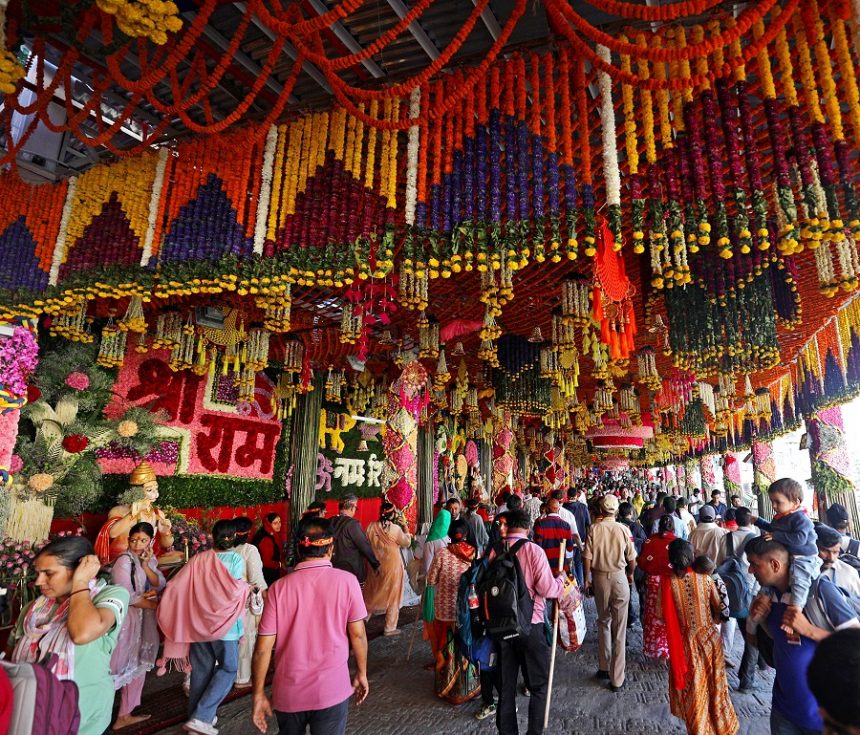In Vijnana Bhairav Tantra, Parvati asks Shiva, “What is this Universe and by what power does it sustain itself”? if this question is to be relooked from the frame of Navratri, then the same question can be rephrased where Shakti is asking Shiva, “What is the nature of the cycle of creation, preservation, transformation and dissolution? This question will encompass the essence of the nine forms of Shakti, where Shakti seeks to understand the purpose and meaning behind her dynamic creative energy that manifests the universe and sustains the cycle of existence. This question of Shakti also reflects human quest for understanding deeper truths of nature of existence and reality.
In Kashmir Shaivism, the entire universe is seen as a manifestation of consciousness. The foundational concepts of Prakasha and Vimarsha, along with Chit and Chiti, provides a deep understanding of how this consciousness operates and how creation unfolds from the divine. These concepts are central to the non-dualistic philosophy of Kashmir Shaivism, illustrating the interplay between the static and dynamic aspects of the Divine.
Prakasha and Vimarsha – The Divine Light and Reflective Awareness
In the realm of Kashmir Shaivism, Prakasha ( Chit) represents the pure, self-luminous consciousness of Shiva. It is the unchanging, formless light of awareness, the essence of the Divine that simply is Shiva, in this state of Prakasha, is complete, self-sufficient, and ever radiant. It is beyond time, space, and form, the unchanging reality that underlies everything. Prakasha (Chit) is infinite, indivisible, and the source of all creation. However, Prakasha alone is static—it needs something to recognize its own light and potential.
That is where Vimarsha (Chiti) comes in, representing reflective awareness. It is the aspect of Shiva that reflects upon itself, becoming aware of its own existence and potential. Vimarsha (Chiti) can be understood as the unfolding of consciousness into the universe, where each individual aspect of creation is an expression of Chit in a unique form. According to the Spanda Karikas, this pulsation of consciousness (spanda) is what drives the process of creation, transformation, and dissolution. This reflective aspect, often associated with Shakti (the feminine, dynamic energy), allows the static light of Prakasha to move and create. For example, the Sun ( Prakasha) and the Rays ( Vimarsha), the Ocean ( Prakasha) and the Waves (Vimarsha), the Candle (Prakasha) and the Flame( Vimarsha). Another yet profound example is the Mind and the Thought. The writer’s creative mind is Prakasha and the written words on paper that take the shape of the story is Vimarsha. Without thoughts, the mind would be in a state of pure potential
This dynamic interplay between Prakasha (the static aspect) and Vimarsha (the dynamic, creative aspect) is fundamental to the process of cosmic manifestation. Without Vimarsha, there would be no awareness of creation, and without Prakasha, there would be no foundation for that creation.
Connection to Navaratri and the Nine Forms of Shakti
The celebration of Navaratri, with its focus on the nine forms of Shakti, mirrors this understanding of Prakasha, Vimarsha, Chit, and Chiti. Each form of Shakti represents a different manifestation of Chiti—the dynamic energy of consciousness—at various stages of cosmic creation. From the initial grounding of energy in the form of Shailaputri to the dissolution and renewal seen in Kalaratri, this progression symbolizes how the Divine Mother (Chiti) manifests and reabsorbs the universe in a cyclical process.
The deep cultural practices in India have always personified cosmic energies in the form of deities. Personification makes the abstract accessible and helps the human mind to relate with the images, stories and personalities and by giving divine energies a form like Durga, Lakshmi, Saraswati Kali etc , devotees can form a personal connect.
As we explore the nine forms of Shakti in Navaratri, it becomes clear that these forms are not separate from the ultimate consciousness (Chit) but are expressions of Chiti, the creative aspect of the same consciousness. This understanding reflects the non-dualistic nature of Kashmir Shaivism, where creation and creator are inseparably one. Through this lens, Navaratri becomes not only a celebration of the Divine Mother but also a meditation on the interplay of static consciousness (Chit/Prakasha) and its dynamic power (Chiti/Vimarsha) that sustains the cosmos.
- Shailaputri – The Grounding of Energy
Shailaputri represents the first phase of cosmic creation, where energy grounds itself in the material world. In the context of Kashmir Shaivism, this corresponds to the moment when Chiti begins to manifest the world from the pure, formless consciousness of Chit. The Shiva Sutras describe this as the beginning of the creative process, where the potential of consciousness (Prakasha) starts to unfold through Vimarsha. Shailaputri symbolizes the state of pure potential, much like the initial impulse of creation that sets the universe in motion.
Example: Just like the earth serves as a foundation for all life to grow, Shailaputri is the grounding force, representing stability and the initial framework within which creation begins.
- Brahmacharini – Austerity and Spiritual Practice
In her form as Brahmacharini, Shakti represents the discipline and spiritual practice required to channel energy toward higher realization. This stage mirrors the formative phase of creation in Kashmir Shaivism, where the energy of Chiti is directed with purpose and discipline, shaping the universe. The Vijnana Bhairava Tantra speaks of the importance of austerity and focused energy in reaching higher states of consciousness, symbolized here by Brahmacharini’s dedication to self-realization.
Example: This can be seen in the disciplined flow of energy in nature, such as the steady movement of a river shaping its path over time, channeling its force towards a greater purpose.
- Chandraghanta – Serenity and Balance
Chandraghanta represents serenity and balance in the unfolding creation. The energy of Chiti stabilizes and harmonizes the cosmic forces, reflecting the balance between the static and dynamic aspects of Prakasha and Vimarsha. In the Pratyabhijna Hridayam, the balancing of these cosmic forces is essential to creating a stable universe, and Chandraghanta’s energy symbolizes this harmonization.
Example: Just as the phases of the moon bring balance to the natural world, Chandraghanta brings equilibrium to the forces of creation, ensuring that cosmic energies are aligned and balanced.
- Kushmanda – The Cosmic Egg of Creation
Kushmanda’s form symbolizes the creative burst of energy that brings the universe into being from the cosmic egg (Hiranyagarbha). In Kashmir Shaivism, this corresponds to the moment when Chiti fully manifests the universe from Chit’s formless state. The Shiva Sutras describe this as the ‘explosion’ of consciousness into multiplicity, where the latent potential of Prakasha is ignited into life through Vimarsha.
Example: This is similar to the scientific concept of the Big Bang, where all matter and energy in the universe emerged from a single point, symbolizing the vast creative potential of Chiti.
- Skandamata – Nurturing and Sustaining Life
Skandamata, the mother of Kartikeya (Skanda), symbolizes the nurturing and protective aspect of Shakti. In this phase, Chiti not only creates but sustains and nourishes the universe. The Spanda Karikas describe the pulsating energy of the Divine, which continuously supports and maintains life. Skandamata represents this ongoing nourishment, ensuring the material world remains vibrant and alive.
Example: This is similar to the role of a mother nourishing her child, symbolizing the energy that sustains all creation once it has emerged.
- Katyayani – The Warrior Energy of Transformation
Katyayani, the warrior goddess, represents the active, transformative power of Shakti. In Kashmir Shaivism, this corresponds to the energy of Chiti that brings about transformation and change in the universe. The Rudra Yamala Tantra discusses the constant transformation in the universe driven by Shakti’s dynamic force. Katyayani’s warrior energy ensures that obstacles are overcome, and cosmic order is maintained.
Example: Just as nature constantly evolves—seasons change, species adapt—Katyayani symbolizes the transformative forces necessary for evolution and renewal.
- Kalaratri – The Energy of Dissolution
Kalaratri embodies the destructive power of Shakti, signifying the process of dissolution. In Kashmir Shaivism, Chiti is not only the force of creation but also the energy that dissolves forms back into their original state. The Shiva Sutras emphasize that this dissolution is not an end but a necessary part of the cosmic cycle, as forms must dissolve before new creation can emerge.
Example: This can be compared to how forests regenerate after a fire—destruction paves the way for new life, and Kalaratri represents this cyclical aspect of life and death.
- Mahagauri – Purity and Spiritual Awakening
Mahagauri, the goddess of purity and transformation, represents the stage where material energy begins to evolve toward spiritual enlightenment. In Kashmir Shaivism, this phase aligns with the concept of Pratyabhijna (self-recognition), where the individual soul realizes its divine nature. Mahagauri’s purity symbolizes the soul’s progression from material identification to spiritual awakening.
Example: It’s like a lotus flower emerging from the mud—although rooted in the material world, it rises towards the light, symbolizing spiritual purity and awakening.
- Siddhidatri – Culmination and Union with the Divine
Siddhidatri is the culmination of all forms of Shakti, where the Divine Mother bestows all powers (siddhis) and the individual merges with the universal consciousness. In Kashmir Shaivism, this is the highest state of realization, where Chiti merges back into Chit, completing the cycle of creation, preservation, and dissolution. This is the ultimate goal of self-realization, where the soul (jiva) becomes one with the divine.
Example: This final state is like a drop of water returning to the ocean, symbolizing the individual soul merging with the infinite divine consciousness.
Conclusion
The nine manifestations of Shakti in Navaratri reflect the entire cycle of cosmic creation, preservation, transformation, and dissolution as described in Kashmir Shaivism. Each stage represents a progressive realization of Chiti, the dynamic energy of consciousness, manifesting at different levels of existence. Besides spiritual significance, Navratri’s scientific significance is intertwined with its ability to help human body and mind adapt to natural cycles and seasonal transitions. Fasting, rituals and meditation hehelp detoxify and reset the bod’s system harmonise with cosmic energy cycles and balance physical, mental, and emotional health during times of environmental change








